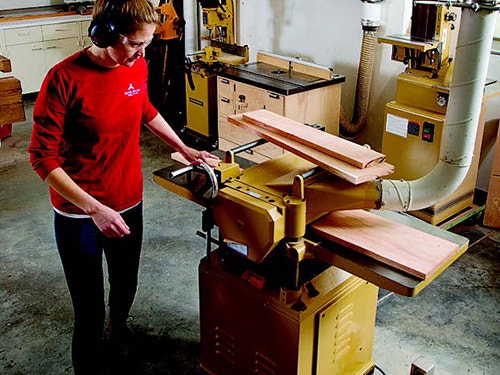How to Flatten Wood without Bowing
I sometimes borrow use of a floor model planer. I have cherry planks that are warped and recycled wood. I learned the hard way that the feed rollers push down hard enough to flatten a bow. I shimmed the bow on a sled to plane the hump off, but that doesn't work well enough. And there's no wide jointer here, so my question: I'm shopping for a portable planer for myself. I've read advice to use a planer as a substitute for a jointer. Are there models that won't put so much pressure on the wood? Or is there a technique I haven't discovered? - J. Brooke Althouse
Tim Inman: Technically, one should use a jointer to flatten one side, then a planer to "thickness" and surface both sides. As a practical matter, this is seldom done in a working shop. If you're going to surface down to something like a standard 3/4 inch, then I think you should be able to get along just fine by being careful and smart when you use your planer. If you're going for 1/8-inch stock, then we might need to talk about making a router sled, for example. Some planers have segmented infeed rollers that could be helpful to you for taking out cupping, but these are usually found on higher-end floor models.
Here's what I'd do: First, be sure the blades in your planer are sharp and set correctly! Dull knives in a cutterhead are never helpful. If you're trying to take the bow out of a board, you need to be able to take light cuts, and turn the wood several times. Begin by running the board through the planer with the cup or "hump" down. Make a light cut. This first step may seem counterintuitive, but it will yield two nice flat little edges on the board for the next cuts. Now flip the board, and take another light cut. This will start truing up the top of the "hump." Once you've made these two passes, just continue making light cuts, flipping the wood as your judgment tells you. You'll need to flip the board several times to get the best surfaces on your wood.
Be gentle and take light cuts! The heavier your cut, the harder the pressure rollers will push down on the wood, flattening the cup but not removing it. The duller the knives, the more they, too, will have to press down on that board to make their cuts. Lighter cuts mean more planer time, but light cuts will almost always give you a nice flat board for your efforts. Once the cup is cut out and the board is flat on both sides, you can take a heavier cut if you want.
Rob Johnstone: While most of us have gotten away with simply running some rough stock through the planer, the proper technique requires flattening one face of the lumber before we do that. A jointer is a common way to do it, but it can be done with a hand plane as well. You mention that you don't have a wide jointer at hand, and I know how frustrating that can be. One alternative is to rip your rough stock into narrower pieces that will fit on your jointer. Number and mark the end grain so that you can the glue the pieces back together after you have surfaced them. If you are careful, the glue lines can be nearly invisible. Not an ideal solution perhaps, but workable.
Chris Marshall: Along with Rob's reasoning, this might be a good opportunity to pick up a long jack and jointer plane and learn how to use them—especially if you don't want to rip, joint and re-glue your wide stock back together again.
Keep the inspiration coming!
Subscribe to our newsletter for more woodworking tips and tricks




